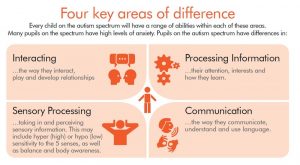What is autism?
Autism is a developmental disorder associated with dysfunction in social interaction and communication. Those diagnosed with Autism Spectrum Disorder (ASD) often engage in repetitive behaviors and/or interests. It’s important the diagnosis is labeled as a spectrum because there is a wide variety of symptomology that can fall on the scale. Some diagnosed are completely non-verbal and need daily care for the entirety of their lives while others go on to be esteemed professors in their field of interest.

What is different in an autistic brain?
There is not just one thing that is different in autism, making it a difficult disorder to pin down. Essentially, there are a number of variables that can influence the development of ASD including genetics environmental factors. Genetically, mutations in a variety of different proteins and genes are seen like SHANK, UBE3A, TSC1-TSC2, and others. Environmentally, increased age of the parents, pregnancy complications and exposure to some teratogens can increase the probability of ASD.
Let’s look at two examples of issues with proteins to see where some of the problems may be occurring:
The protein UBE3A degrades a protein called ARC. The main job of ARC is to reduce the amount of excitatory information by pruning at the synapse. When there are mutations of UBE31, ARC cannot do its job of reducing AMPA channel recruitments and pruning at a normal level and is often overexpressed.
Similarly, problems with genes encoding SHANK proteins are seen in individuals with ASD. Changes and communication need to be made regularly at the synapse and when the genes that help with the changes and communications mutate and don’t encode correctly, we see some of the behavioral issues known to be present in ASD like repetitive routines and anxiety-like phenotypes. One study on Shank2 suggested that mutations in the gene encoding process are alleviated by a partial agonist of NMDA receptor function suggesting that problems with NMDA receptors may be an important indicator of ASD.
What treatments are available
SHANK3 is one of the genes that encode the SHANK family of proteins. Some have found that restoration of SHANK3 levels in adulthood may be helpful in alleviating some of the impairments created by its mutations. This may seem like a step in the right direction but not everybody feels the same way. The video below talks a little more about the SHANK3 gene and how it works.
Some individuals in the autistic community take issue with the word “cure” as they don’t feel there is anything to be cured. For some, the diagnosis is an important aspect of their personality and not a detriment but an asset to their lives. It can be argued that trying to “cure” autism is simply trying to make sure everyone fits into the neuro-typical mold and eliminates variance in society. While there are those whose lives are severely impacted by ASD and are in immense pain and discomfort, we must be wary of labeling things a “treatment” versus a “cure” as those terms can mean different things to different people. If we “cured” autism, we may not have had Hans Christian Andersen’s famous children’s stories or Bobby Fischer’s incredible chess talent. Yet, we must not point to celebrity success as the only reason ASD should not be eliminated as each individual contributes uniquely to society.
Sources:
https://www.researchgate.net/publication/313495385_SHANK_proteins_roles_at_the_synapse_and_in_autism_spectrum_disorder
www.autismspeaks.org
